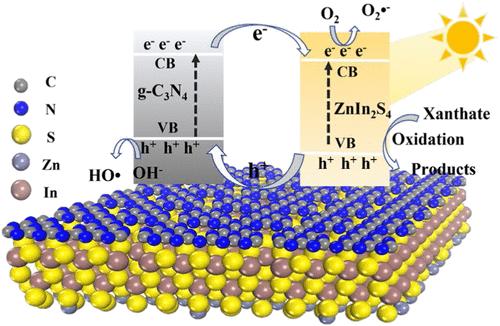Visible-Light-Driven Photocatalytic Degradation of Xanthate in Flotation by g-C3N4/ZnIn2S4 Heterojunction: Experimental and DFT Studies
IF 3.9
2区 化学
Q2 CHEMISTRY, MULTIDISCIPLINARY
引用次数: 0
Abstract
Graphitic carbon nitride (g-C3N4) and zinc indium sulfide (ZnIn2S4) were combined to form CN/ZIS composite materials via a hydrothermal method. The CN/ZIS composites were extensively characterized before they were used for photocatalytic degradation of sodium isobutyl xanthate (SIBX). Results revealed that 3CN/ZIS outperformed other materials, as evidenced by SIBX degradation efficiency of about 8.16 and 5.46 times greater than that of g-C3N4 and ZnIn2S4, respectively. The improved activity results from the combination of g-C3N4 and ZnIn2S4. The synergistic effect leads to an enlarged surface area, stronger light absorption, more efficient charge carrier separation, and reduced recombination rates. The mechanisms behind the photocatalytic degradation of SIBX using CN/ZIS were then proposed based on density functional theory (DFT) calculations, band structure analysis, and oxidation–reduction potential. The results verified the successful construction of a Type-II heterojunction between g-C3N4 and ZnIn2S4. Furthermore, cyclic experiments demonstrate that 3CN/ZIS maintains high degradation efficiency after five cycles, indicating strong chemical stability and promising industrial potential.

g-C3N4/ZnIn2S4异质结在可见光驱动下光催化降解浮选中的黄药:实验和DFT研究
采用水热法制备了石墨氮化碳(g-C3N4)和硫化锌铟(ZnIn2S4)。在将CN/ZIS复合材料用于光催化降解异丁基黄药钠(SIBX)之前,对其进行了广泛的表征。结果表明,3CN/ZIS的SIBX降解效率分别是g-C3N4和ZnIn2S4的8.16倍和5.46倍,优于其他材料。g-C3N4与ZnIn2S4的结合提高了活性。协同效应使材料表面积增大,光吸收增强,载流子分离效率提高,复合率降低。基于密度泛函理论(DFT)计算、能带结构分析和氧化还原电位,提出了CN/ZIS光催化降解SIBX的机理。结果证实g-C3N4与ZnIn2S4之间成功构建了ii型异质结。此外,循环实验表明,3CN/ZIS经过5次循环后仍保持较高的降解效率,具有较强的化学稳定性和良好的工业潜力。
本文章由计算机程序翻译,如有差异,请以英文原文为准。
求助全文
约1分钟内获得全文
求助全文
来源期刊

Langmuir
化学-材料科学:综合
CiteScore
6.50
自引率
10.30%
发文量
1464
审稿时长
2.1 months
期刊介绍:
Langmuir is an interdisciplinary journal publishing articles in the following subject categories:
Colloids: surfactants and self-assembly, dispersions, emulsions, foams
Interfaces: adsorption, reactions, films, forces
Biological Interfaces: biocolloids, biomolecular and biomimetic materials
Materials: nano- and mesostructured materials, polymers, gels, liquid crystals
Electrochemistry: interfacial charge transfer, charge transport, electrocatalysis, electrokinetic phenomena, bioelectrochemistry
Devices and Applications: sensors, fluidics, patterning, catalysis, photonic crystals
However, when high-impact, original work is submitted that does not fit within the above categories, decisions to accept or decline such papers will be based on one criteria: What Would Irving Do?
Langmuir ranks #2 in citations out of 136 journals in the category of Physical Chemistry with 113,157 total citations. The journal received an Impact Factor of 4.384*.
This journal is also indexed in the categories of Materials Science (ranked #1) and Multidisciplinary Chemistry (ranked #5).
 求助内容:
求助内容: 应助结果提醒方式:
应助结果提醒方式:


